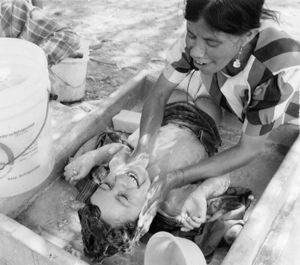Hesperian Health Guides
Chapter 39: Bathing
For the baby or small child, some kind of a tub may be a big help.
 Next we wash your legs. |
 Now slowly down, into the water. |
| A rectangular tub of the size you need can be made out of mud or mud bricks (or dried bricks) and covered with a thin layer of cement. | This is a good way to hold the child who stiffens and bends backward, or throws open her arms when you pick her up. |
 |
A baby that tends to stiffen backward can sometimes be held like this for bathing. |  |
| Gently spread the child’s legs as wide as possible to clean between them. Also, lift arms high above the head. In this way, bathing can be combined with range-of-motion exercises (see Chapter 42). |  |
|
| A mother bathes her child in a cement wash tub. (PROJIMO) |
As the child grows, make every effort to help her take part in bathing herself. Help her do more and more until she can bathe herself without help, if possible.
Our goal in bathing is SELF-CARE, even for children with severe disabilities
For many children balance is difficult, even while sitting. Anything that can help the child keep his balance, and stay in a position where he has the most control, will help make bathing easier. Here are some aids and suggestions for supporting a child who has difficulty with balance.
| The child who has trouble sitting because she stiffens backward may need some kind of back support to sit while bathing. |  |
CAUTION! Be sure water is clean and does not spread disease. |
| 2 old car tires (or inner tubes) tied together | Especially for the child who does not have good bowel or urine control, it is very important to carefully clean her butt and between her legs. An inner tube on poles, like this, holds her in a good position for washing. |

Note: Anything that keeps the hips bent up like this will help keep a child with spasticity from stiffening and bending backward. | |
 |
| a bath seat made from half a plastic bucket or laundry basket on a tube frame | a stool with a seat woven from strips of car tire inner tube |
 |
 |
| Heat the edges to bend them around the tubing. | From the UPKARAN Manual. |
| a washing platform of wooden slats for the child who washes (or is washed) lying down | |
 waterproof pillow made from a section of old inner tube
glue ends shut with rubber tube patching ‘cement’. | |
| Also see the bicycle inner tube mat. |
| A soap mitt, made of a piece of towel and a tie string (or Velcro straps), lets the child who has difficulty grasping use both the washcloth and soap more easily. |  soap mitt |
Bath time is a good time to help a child develop many different skills. Encourage her to handle and play with toys in the water, repeat words, and imitate actions. Let her feel the difference between a sponge and a cloth, or dry and wet and soapy. To learn to use both hands together, let her squeeze water out of the sponge.

To help the child learn how to bathe herself, let her first wash her toys and dolls.
Show her how and encourage her to copy you. For a child who is afraid of the water, letting her bathe a doll or toy first may calm her fears.
Toys that float in the water make bathing more fun. Use corks, bits of wood, or plastic bottles with lids on them. Making little boats with sails or ‘paddle wheels’ makes it more fun and helps the child learn to use her hands better. The child with weak lips or who drools can play by blowing the boat across the water.
For the child with limited control or strength, it is often easier to play in the water with toys that float than it is to play with toys out of the water.
| gourd (Pour mud or plaster in bottom and let it dry so that gourd floats upright.) | ||||||
 |
 | |||||
| plastic bottle | cork | mud (inside) | balloon | nut shell | rubber band |
paddle made from tongue depressor or piece of bark |
Drying the child can also become a game that aids development. Rub the child, sometimes gently and sometimes briskly, with a rough cloth or towel. Name the different parts of her body as you rub them. Remember, as you bathe and dry the child, talk about each thing you do—or sing a song about it! Move the towel with the music, and encourage the child to move with you. Use your imagination to make it more fun and to help her learn.
Use bath time as an opportunity for learning and play.


